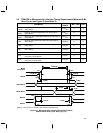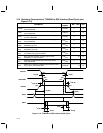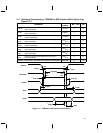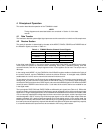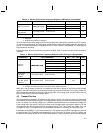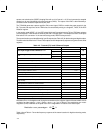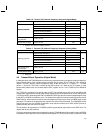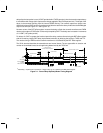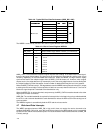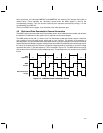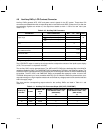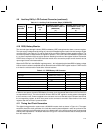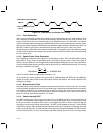
4–5
Table 4–6. Transmit (TX) Channel Frequency Response (Digital Mode)
PARAMETER TEST CONDITIONS MIN TYP MAX UNIT
F
0 kHz to 8 kHz (see Note 4) ±0.3
dB
F
8 kHz to 15 kHz (see Note 4) ±0.5
dB
Frequency response
20 kHz to 45 kHz (see Note 2) –29
dB
F
requency response
45 kHz to 75 kHz (see Note 2) –55
dB
> 75 kHz (see Note 2) –60
Any 30 kHz band centered at > 90 kHz (see Note 2) –60
Peak-to-peak group
delay distortion
0 kHz to 15 kHz 3 µs
Absolute channel delay 0 kHz to 15 kHz 320 µs
NOTES: 2. Stopband
4. Deviation from ideal 0.35 SQRC response
Table 4–7. Transmit (TX) Channel Frequency Response (Analog Mode)
PARAMETER TEST CONDITIONS MIN TYP MAX UNIT
F
0 kHz to 8 kHz (see Note 1) ±0.5
dB
F
8 kHz to 15 kHz (see Note 1) ±0.5
dB
Frequency response
20 kHz to 45 kHz (see Note 2) –31
dB
Frequency
response
45 kHz to 75 kHz (see Note 2) –70
dB
> 75 kHz (see Note 2) –70
Any 30 kHz band centered at > 90 kHz (see Note 2) –70
Peak-to-peak group
delay distortion
0 kHz to 15 kHz 3 µs
Absolute channel delay 0 kHz to 15 kHz 540 µs
NOTES: 1. Ripple magnitude
2. Stopband
4.4 Transmit Burst Operation (Digital Mode)
In the digital mode, the TCM4300 performs all encoding, signal processing, and power ramping for the burst.
Start and stop timing of the variable length bursts are set by means of the TXGO bit in the DStatCtrl
register. The SINT interrupt output interrupts the DSP at 48.6 kHz which is T/2 interval (T = 1 symbol
period = 1/24.3 kHz). The burst is initiated by the DSP writing 1 to 5 dibits to the TXI register, a small
positive-delay offset value d to the base station (BST) register, and a 1 to the TXGO bit in the DStatCtrl
register.
The TXGO bit is sampled on the falling edge of SINT. The transmit outputs are held at zero differential
voltage (each output terminal is held at the voltage supplied to the VCM input terminal) for 9.5 SINT periods
(195.5 µs) plus BST offset delay after SINT has detected TXGO high; then the transmit outputs begin to ramp
to the initial π/4 DQPSK constellation value. The shape of the ramp is the transient resulting from the internal
SQRC filtering. At the same time that the transmit outputs are beginning to ramp, the PAEN digital output
goes high. This output can enable the power amplifier of a cellular radio transmitter. The TCM4300 transmit
outputs reach the first π/4 DQPSK constellation value (maximum effect point, MEP) 6 SINT periods (3
symbol periods) after the start of the ramp.
The bit stream to be encoded as π/4 DQPSK symbols is generated by right shifts on each SINT of the TXI
register with bit 0 (LSB) used first.
Previously written data continues to propagate through the TCM4300 internal filters until the last π /4 DQPSK
constellation value (last MEP) occurs at the transmit outputs 15.5 SINT periods (318.9 µs) plus BST offset



